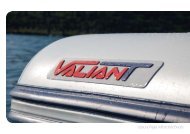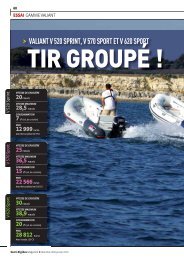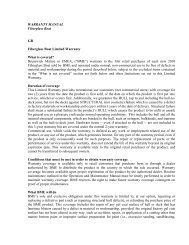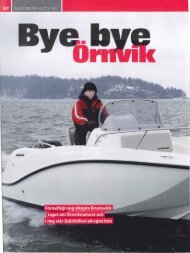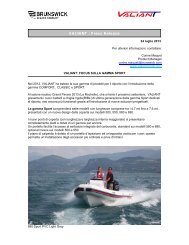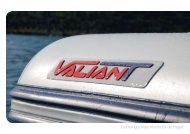899883192 - Valiant
899883192 - Valiant
899883192 - Valiant
You also want an ePaper? Increase the reach of your titles
YUMPU automatically turns print PDFs into web optimized ePapers that Google loves.
Instrumentation<br />
• consuming alcohol or drugs<br />
• high speed boating maneuvers<br />
Section 2 - Getting to Know Your Power Package<br />
The lanyard is a cord usually between 122 and 152 cm (4 and 5 ft) in length when stretched<br />
out, with an element on one end made to be inserted into the switch and a snap on the<br />
other end for attaching to the operator. The lanyard is coiled to make its at‐rest condition<br />
as short as possible to minimize the likelihood of lanyard entanglement with nearby objects.<br />
Its stretched‐out length is made to minimize the likelihood of accidental activation should<br />
the operator choose to move around in an area close to the normal operator's position. If<br />
it is desired to have a shorter lanyard, wrap the lanyard around the operator's wrist or leg,<br />
or tie a knot in the lanyard.<br />
Activation of the lanyard stop switch will stop the engine immediately, but the boat will<br />
continue to coast for some distance depending upon the velocity and degree of any turn<br />
at shut down. However, the boat will not complete a full circle. While the boat is coasting,<br />
it can cause injury to anyone in the boat's path as seriously as the boat would when under<br />
power.<br />
We strongly recommend that other occupants be instructed on proper starting and<br />
operating procedures should they be required to operate the engine in an emergency (e.g.<br />
if the operator is accidentally ejected).<br />
! WARNING<br />
If the operator falls out of the boat, stop the engine immediately to reduce the possibility<br />
of serious injury or death from being struck by the boat. Always properly connect the<br />
operator to the stop switch using a lanyard.<br />
Accidental or unintended activation of the switch during normal operation is also a<br />
possibility. This could cause any, or all, of the following potentially hazardous situations:<br />
• Occupants could be thrown forward due to unexpected loss of forward motion, a<br />
particular concern for passengers in the front of the boat who could be ejected over the<br />
bow and possibly struck by the propulsion or steering components.<br />
• Loss of power and directional control in heavy seas, strong current or high winds.<br />
• Loss of control when docking.<br />
! WARNING<br />
Avoid serious injury or death from deceleration forces resulting from accidental or<br />
unintended stop switch activation. The boat operator should never leave the operator's<br />
station without first disconnecting the stop switch lanyard from the operator.<br />
VesselView<br />
Your power package may come equipped with the following system viewer.<br />
90-<strong>899883192</strong> NOVEMBER 2008 Page 27




